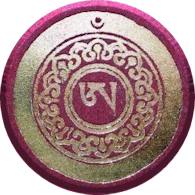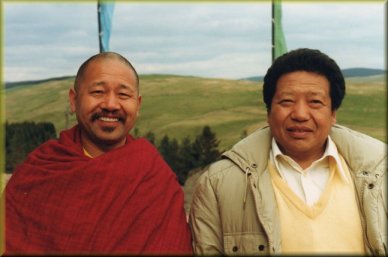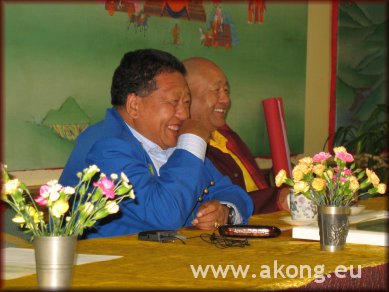
Akong Rinpoché Establishing Buddha-Dharma
Part Twelve: Seeing the Bodhisattva Cope with Change
 One of my tasks during the late 1980s, given to me by Akong Rinpoché, had been to keep an eye open for promising people—those with enough commitment, integrity and intelligence to be trained (mainly by me) as future teachers of dharma theory or as translators. I had identified one or two and had started training them. With Lama Yeshe Losal as the new Abbot, it became clear that anyone with commitment who fitted that bill would now almost certainly be encouraged to enter the
long retreat—doing, if possible two or three retreats in a row—and that dharma studies were no longer really "the flavour of the day". This was a major disappointment to me, having until then witnessed and assisted in some fifteen years of dedicated effort by Akong Rinpoché to establish good studies at Samye Ling.
One of my tasks during the late 1980s, given to me by Akong Rinpoché, had been to keep an eye open for promising people—those with enough commitment, integrity and intelligence to be trained (mainly by me) as future teachers of dharma theory or as translators. I had identified one or two and had started training them. With Lama Yeshe Losal as the new Abbot, it became clear that anyone with commitment who fitted that bill would now almost certainly be encouraged to enter the
long retreat—doing, if possible two or three retreats in a row—and that dharma studies were no longer really "the flavour of the day". This was a major disappointment to me, having until then witnessed and assisted in some fifteen years of dedicated effort by Akong Rinpoché to establish good studies at Samye Ling.
This, therefore, became an important opportunity for me to try to do exactly what Akong Rinpoché himself was doing, i.e. accepting the new situation and letting Lama Yeshe find his own way, as that could be the only recipe for success and knowing that Lama Yeshe’s success was vital and would be the success of Samye Ling itself. Akong Rinpoché was obviously "an impossible act to follow" and neither Akong Rinpoché nor Lama Yeshe himself expected Lama Yeshe to simply continue things as before, with Lama Yeshe somehow stepping effortlessly into Rinpoché’s shoes as a doppelgänger and Samye Ling continuing just as it always had been. As Lama Yeshe often said, I am not my brother!
Rinpoché, who had been trained from infancy to be an abbot and to take responsibility for guiding individuals and institutions, must have realised just how much he was “throwing his brother in at the deep end” and for that reason he gave him every possible support and freedom to act. Akong Rinpoché’s wisdom shone through in that transitional period, as he made it more and more clear that he would no longer let himself drawn into the rights or wrongs of specific Samye Ling situations or dramas—which, had he done so, would have been a certain formula for divisions in the community—but instead focused on the bigger picture of establishing Lama Yeshe as well as was possible in his new role and of getting people used to that new reality. Indeed, later, enriched by the experience of this transition, he made very careful moves to introduce his own choice as the future successor of Lama Yeshe, i.e. Kating Lama, at an early stage, in various key public events starting from as early as 2009.
In the first years of this process, Akong Rinpoché did all he possibly could to smoothe the transition from his leadership to that of Lama Yeshe, even saying skilfully in public things like, We are the same. There is no difference betwen us, in order to quell some people’s uneasiness with the changed face of Samye Ling—a Samye Ling no longer a pyramidal structure with him very hands-on present in the community itself and also ever-present as a decider and reference at its apex. He even joked that Lama Yeshe was probably the real Akong reincarnation and that they had got the wrong one when they found him. In private, however, Rinpoché was much more pragmatic, embracing impermanence and destiny by recognising both the opening-up of the next chapter in his own personal (enlightened) activity (in Tibet, with the Karmapa and Rokpa) and also the next chapter of his brother’s own unusual and extraordinary evolution along a strenuous learning-curve.
 Akong Rinpoché’s own efforts to establish or re-establish good and pure academic training in buddhadharma shifted then to Tibet where, as the years went by, he created or established more and more projects dedicated to primary and secondary education and he supported monastic colleges of all traditions. Also, back home, in the one-to-one interviews, he continued to encourage suitable people to study, often sending them to me as a tutor. He made continued attempts to establish more structured study programmes in the Samye Dzongs of Europe and Africa. However, these met with varied success, for different reasons. The study programme in the Spanish Dzongs, established and run by Lamas Jinpa and Tsondru, had a large following and worked very well indeed.
Akong Rinpoché’s own efforts to establish or re-establish good and pure academic training in buddhadharma shifted then to Tibet where, as the years went by, he created or established more and more projects dedicated to primary and secondary education and he supported monastic colleges of all traditions. Also, back home, in the one-to-one interviews, he continued to encourage suitable people to study, often sending them to me as a tutor. He made continued attempts to establish more structured study programmes in the Samye Dzongs of Europe and Africa. However, these met with varied success, for different reasons. The study programme in the Spanish Dzongs, established and run by Lamas Jinpa and Tsondru, had a large following and worked very well indeed.
Several things happened in the 2000s that revived Akong Rinpoché’s original hopes for good studies to be happening in the European centres he had founded. One of them, due to the Holy Isle Project being now well under way, was the reinvestment of energy and human resources into the Samye Project, making the College re-appear, from the far-over-the-future-horizon it had become to being once again an approaching reality. Another thing was the appearance of the Home Study course—a three-year, distance-learning training programme developed by the author according to Rinpoché’s basic wish to take people through a Hinayana-Mahayana-Vajrayana awakening to Buddhist ideas. This has since been taken up by some thousand people in thirty-five countries and it was something Rinpoché often encouraged people to undertake; more and more so in the latter years of his life. It is called Nangi Shedra.
The other main factor that revivified study was the appearance in the Samye Ling mandala of two of the finest contemporary masters. The first was the extraordinary and much sought-after master, Drupon Rinpoché, Khenpo Lhabu, who had progressed from being a young and unknown monk to being installed as a master of Mahamudra and a lineage-holder, all by the age of thirty-two. He had subsequently been “head-hunted” from Tibet by Khenchen Thrangu Rinpoché, to care for both the latter’s retreat centres and study institutions—shedra. Akong Rinpoché asked him to take charge of the Samye Ling long-term retreats and also to establish some shedra studies in Samye Ling, which he has done very successfully, having (to date) taught intense study courses each year for five years, covering many of the main topics originally envisaged through Akong Rinpoché’s own dialogues with the Karmapa, Khenchen Thrangu Rinpoché and the Very Venerable Kalu Rinpoché. Thus there was, from 2008 onwards, the Shedra, the Nangi Shedra and the up-coming College.
The other master to be brought to Samye Ling was Khenpo Damchö Dawa, the principal of the Tulku College in Yushu, Tibet. Akong Rinpoché had arranged for him to come in the early 2000s but ill-health prevented this for some years. He visited Samye Ling and some Samye Dzongs in 2011, 2012 and 2013, sharing his wonderful erudition and compassion. Many times Akong Rinpoché expressed his own respect for these two teachers: respect for their learning, for their meditation insight, for their human qualities and for their purity of being. In the 2000s, Rinpoché often said that the completion of the College was the last item on his list of major things to be done. Tragically, ironically, he died only months after the completion of its construction.
One thing strikes the author very vividly looking back on the past twenty years. Anyone who has given a major part of their life to pioneering a project or even to doing a singular job will know the difficulties of then having to hand it over to someone else: the fear that they will not do it so well, the pain of seeing them do it differently than one would have done oneself and so forth. In this case, one can add the complexity of sibling relationships. In reviewing the life journeys of Chöjé Akong Rinpoché and Lama Yeshe Rinpoché, one is struck by the qualities of acceptance shown on each side as Akong Rinpoché handed over the reins of Samye Ling to his brother. Akong Rinpoché had to accept the experience of observing the organisation he had nurtured so carefully pass into, and then change in, the hands of his inexperienced brother. Lama Yeshe, engineered reluctantly out of his own chosen path, strict retreat, by his elder brother and then pressured more and more into positions of unwanted responsibility, had to take on the tasks given, out of his deep devotion to the dharma and his respect for his brother. Their joint story gives great grounds for reflection and for admiring them both. In this particular biography, focused on Akong Rinpoché, the author would note Rinpoché’s perfect acceptance of the situation, as both “karma” and a pragmatic necessity. The respect that he showed for Lama Yeshe and the power and freedom he gave him, interfering as little as possible, was admirable. He gave us a textbook example of how a bodhisattva acts in such a situation.
.....this narrative continues: Establishing the Dharma as Practice
